Innovative Use Of Architectural Materials
By Pankhuri Goel | December 06, 2018
Materials form a large part of our memory of spatial experiences as long as they are authentic and create a unique story. A material palette must help create an authentic, cohesive identity of a space while responding to the uniqueness of its context.
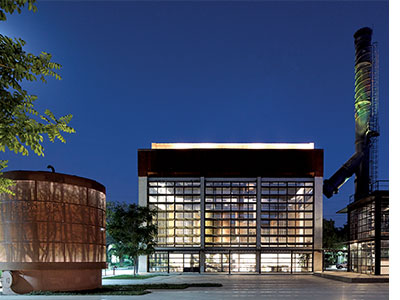 Our experience of a space is determined first by the volume it occupies and secondly by the tactility of the materials which establish the character of the space and give it a personality. Materials form a large part of our memory of spatial experiences as long as they are authentic and create a unique story.
Our experience of a space is determined first by the volume it occupies and secondly by the tactility of the materials which establish the character of the space and give it a personality. Materials form a large part of our memory of spatial experiences as long as they are authentic and create a unique story.
At Studio Lotus for instance, this choice is influenced by the vision we hold for each project; we believe that a material palette must help create an authentic, cohesive identity of a space while responding to the uniqueness of its context.
Innovation of material usage should be pared back to focus on technique and processes. By contemporising craft, the use of everyday materials can yield captivating results. Artisans can be 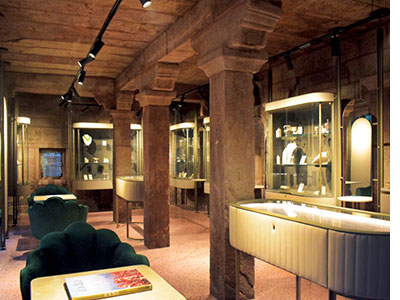 trained to adapt their crafts to modern sensibilities, creating bespoke solutions which while creating a unique identity for a space also provide a platform for revival of dying crafts. In fact, an extensive and iterative process of value engineering can help ensure financial viability of customised solutions, ensuring the cost-effectiveness associated with off-the-shelf solutions.
trained to adapt their crafts to modern sensibilities, creating bespoke solutions which while creating a unique identity for a space also provide a platform for revival of dying crafts. In fact, an extensive and iterative process of value engineering can help ensure financial viability of customised solutions, ensuring the cost-effectiveness associated with off-the-shelf solutions.
While material application is always seen as a process of ‘addition’, we have through our work explored using material as a process of ‘subtraction’ through revealing the basic structure and materiality of a space – this is especially relevant for historic sites. For the Gem Palace retail outlet at the Raas Jodhpur, for instance, we stripped down the cement plaster from the 18th century premises to reveal the stone masonry beneath, which helped reinforce the linkage 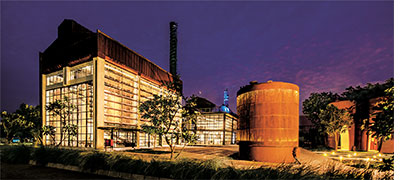 between the heritage brand with its historic locality. The crafted, polished fixtures and fittings in the space encased in metal and glass created a unique contrast to the historic shell.
between the heritage brand with its historic locality. The crafted, polished fixtures and fittings in the space encased in metal and glass created a unique contrast to the historic shell.
Another innovative use of architectural materials can be explored through the concept of ‘Wabi-Sabi’, which uses the aging of materials over time as its core principle. We adopted this approach for the design of the award-winning Godrej Imagine Studio at The Trees in Vikhroli, Mumbai, through the materiality of concrete, corten steel, brass and timber. The complex stood where the erstwhile Godrej Industrial Complex once did, and the choice of material helped assert a sense of continuity. While concrete indicates the existing shell work, corten steel reinterprets the idea of the original form, which over a period of time bleeds over concrete. This helped cultivate an authentic industrial aesthetic, in tune with the cultural legacy of the area in which it was situated.
The idea of innovation, ultimately, must be looked at in terms of the project intent; there is no one-size-fits-all approach that can be adopted to push the envelope in the field of design. Adaptation of traditional wisdom using contextual cues can be just as effective as technological innovations undertaken with a futuristic vision as designers, the responsibility of choosing the appropriate approach is completely ours.
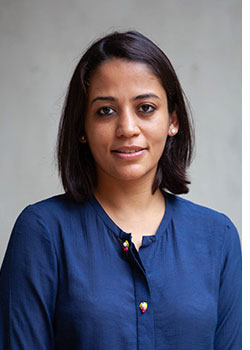 About Pankhuri Goel
About Pankhuri Goel
Pankhuri Goel, Design Principal, Studio Lotus is a graduate from National Institute of Design. She is one of the five Design Principals of Studio Lotus, as part of her internationally acclaimed practice for the past 9 years. Under her leadership, Studio Lotus is acknowledged as a thought leader in the country for their work in the domain of Architecture and Interior Design, especially with conscious design sensibilities, cultural influences, local resources etc. Pankhuri has played a critical role in the studio winning numerous accolades and awards, contributing to the sustained growth and proliferation of the practice.
Related Viewpoints
Chanda P Kumar
Chanda P Kumar, Associate Director- Marketing & Communications, Strategy , FRDC
Adding the right sparkle in jewellery store design

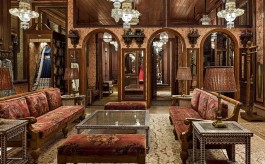
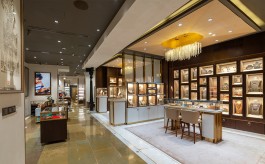
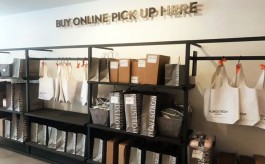

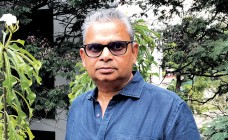



Comments